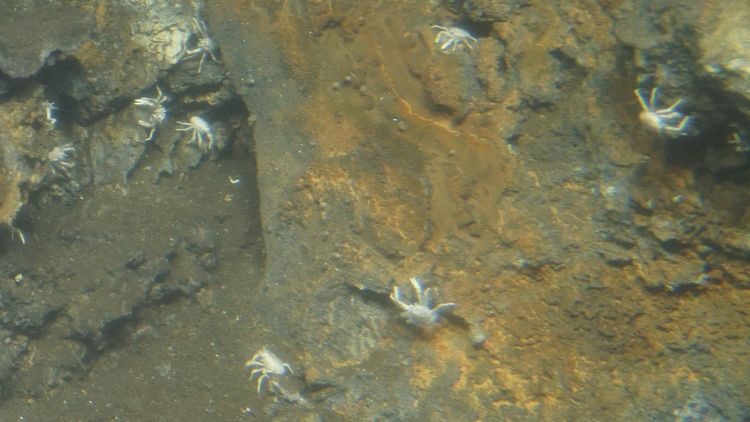Diving down to hydrothermal vents: first analysis of the microbial community living on the carapaces of deep-sea squat lobsters
Hydrothermal vents on the seafloor are home to some unusual communities. The galatheid squat lobster species Munidopsis alvisca is among the organisms commonly found at hydrothermal vent sites in the Gulf of California. In an article published in the open access journal Scientific Reports, an international research team led by Janina Leinberger and Prof. Dr. Thorsten Brinkhoff from the Institute for Chemistry and Biology of the Marine Environment (ICBM) of the University of Oldenburg reports that these small, white crustaceans are hosts to their own special ecosystem. The Oldenburg scientists have conducted the first-ever analysis of the microbial community living on the carapaces of these crustaceans. They found significant differences between the composition of this microbiome and other microbial communities in the vicinity, such as those in the sediment or the surrounding seawater.
The team suspects that both the microbes and the squat lobsters benefit from their close relationship. Numerous methane and sulphur-reducing bacteria were found to be among the inhabitants of the squat lobsters' carapaces. These single-celled organisms specialize in utilizing energy-rich chemical compounds such as hydrogen sulphide and methane which are present in the water that flows into the sea from the hydrothermal vents. "The squat lobsters' carapace provides these organisms with a stable habitat in close proximity to the nutrient-rich hydrothermal fluids," Brinkhoff explains. The scientists speculate that for their part, the squat lobsters may use the bacteria living on their carapace as a source of nutrients. Another possibility is that the microbes help to remove toxic hydrogen sulphide from the crustaceans' bodies. This substance inhibits respiratory processes in higher life forms, which is why some inhabitants of deep-sea hydrothermal vents live in symbiosis with sulphur-reducing bacteria. But as the researcher notes, "So far very little is known about the interactions between microbes and crustaceans."
Brinkhoff took part in a 2018 expedition with the US research vessel Atlantis to the Guaymas Basin in the Gulf of California, where the earth's crust is spreading and consequently there are numerous active hydrothermal vents on the seafloor. The research submersible Alvin made several dives to some of these vents. Brinkhoff was on board when the Alvin headed for a rocky structure called Rebecca's Roost, located at a depth of around 2,000 metres. Mineral-rich fluids that can reach temperatures of more than 300 degrees Celsius flow from the seafloor and several vents into the surrounding seawater, which is cold at a temperature of just four degrees Celsius . "Down there, you are in a special world," says the microbiologist. In contrast to the deep-sea floor, which tends to be relatively barren, the areas surrounding the hydrothermal vents are teeming with life. Through the porthole of the submersible Brinkhoff was able to observe tubeworms, fish, starfish, squid, jellyfish – and lots of tiny squat lobsters.
The three crew members – in addition to Brinkhoff two pilots were on board to steer the submersible – brought ten specimens of these crustaceans to the surface. The subsequent genetic analysis revealed that all of them belonged to the same species and that their carapaces were home to a diverse microbiome. The composition of the microbial community was very similar in each of the individual specimens. The research team sees this as an indication that both sides benefit from their relationship. "These microbes probably have a similar function to those that live on the skin of humans – namely, to defend their host," explains Brinkhoff. The scientist's original intention was to examine the squat lobsters for signs of the globally widespread burn spot disease, which causes black spots on the shells of all kinds of crustaceans, from krill to lobsters, and could potentially be related to their bacterial inhabitants. "However, there was no evidence of this disease in the deep-sea crustaceans," Brinkhoff reports. In the next step, the researcher hopes to find out exactly how squat lobsters benefit from the presence of their microbial guests.
Contact: Prof. Dr. Thorsten Brinkhoff, Phone: 0441/798-3269, Email: t.brinkhoff@icbm.de

![[Translate to English:]](/f/5/_processed_/3/2/csm_ICBM-Logo-transparent-_91fe1c6774.png)
